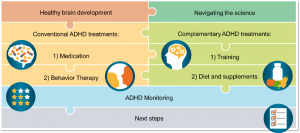Studies reinforce the critical importance of ADHD treatment monitoring

__________
As the new school year approaches, let me highlight the essential value of ADHD treatment monitoring. Even when a child’s treatment has been going well, response to treatment can change over time. This is true for medication treatment, or any other treatment a child is receiving. By regularly monitoring how a child is doing at school, parents and professionals are alerted early on to when modifications and adjustments to a child’s treatment is needed. This can prevent substantial time from going by when a child is struggling more than may be necessary.
When a child is diagnosed with ADHD, parents confront the difficult decision about which treatment(s) to pursue to best help their child succeed. While deciding on an initial treatment plan is certainly important, equally important is establishing a plan to monitor how well that treatment is working on a sustained basis, regardless of what specific treatment(s) is being used. This is because children’s response to ADHD treatment often changes over time and a strong initial treatment response – be that medication treatment, behavior therapy, dietary treatment, etc., — provides no assurance that important treatment benefits will persist.
Core ADHD symptoms of inattention and hyperactivity-impulsivity that are well-controlled at one time may subsequently reemerge and create difficulties. A child’s success with school work, meeting behavioral expectations at school, and getting along with peers can also ebb and flow. For this reason, ADHD treatment guidelines from the American Academy of Pediatrics and the American Academy of Child and Adolescent Psychiatry highlight the necessity of sustained, systematic treatment monitoring. This is essential for learning whether an initial treatment regimen is having the intended benefits and, if so, whether those benefits are persisting. If that is not the case, one wants to be alerted as soon as possible so that appropriate treatment adjustments and modifications can be made. Having a strong monitoring plan in place is thus an integral component of high quality ADHD treatment.
Evidence for the importance of treatment monitoring
The value of careful treatment monitoring was highlighted in results from the Multimodal Treatment Study of AD/HD. (i.e. the MTA study), the largest ADHD treatment study ever conducted. In this study, nearly 600 7–10 year old children with the combined type of ADHD were randomly assigned to one of four treatment conditions: medication treatment, behavior therapy, combined treatment (medication + behavior therapy), or community care, i.e., treatment in the community. Children assigned to the first three groups received their treatment through the study. Those assigned to the community care group received whatever treatment their parents chose to pursue in the community; nearly two-thirds of the time this included medication treatment.
Medication treatment in the MTA Study began with a rigorous titration trial in which three different doses of an initial stimulant medication were tried. Feedback on children’s behavior and school performance was obtained from parents and teachers and this information was used to determine the optimal starting dose. If no dose of the initial medication was sufficiently effective, or if it produced adverse effects, a different medication was tried. The goal of this procedure – which is far more extensive than what typically occurs – was to identify the most effective medication and dose to begin each child’s treatment.
After treatment began its ongoing effectiveness of treatment was monitored via monthly follow-up visits and phone contact with teachers. The purpose was to learn how well children’s ADHD symptoms were being controlled over time and how well they continued to function in behavioral, academic and social domains. Although one might assume that the careful procedure used to identify the optimal starting medication and dose for each child would obviate the need for treatment adjustments, this did not turn out to be the case.
Three months into the 13-month maintenance period, 56% of children had already had their medication or dosage changed. The average time to the first dose change was 4–5 months. Across the entire maintenance period, the average number of changes required for each child was just over 2, but some children required as many as 10 medication adjustments. Of the total medication changes made, 62% involved increasing the dosage of the current medication, 31% involved decreasing the dosage and only 7% involved changing medications entirely. Only 17% continued on the same medication and dosage throughout the entire 13-month maintenance period. The remaining children all experienced at least one change in drug or dosage during this period.
In contrast to the monthly monitoring that children treated in the study received, those treated in the community (again maybe a descriptor) averaged just 2 follow-up visits and it is unlikely that direct feedback from teachers was obtained. Thus, their providers had far less information on how well they were doing and their medication regime was less likely to be adjusted in response to feedback from parents and teachers. Although it cannot be concluded with certainty, it is likely that this helps explain why children who received medication treatment through the study were significantly more likely to have their core ADHD symptoms normalized than children treated in the community.
Although these results pertain to medication treatment, the need for careful ongoing monitoring is applies to whatever treatment(s) a child is receiving. Regardless of treatment, it is essential to know how well core ADHD symptoms are being managed and how the child is performing in important domains. When this information is not obtained on a regular basis, it is not possible to know when modifications to the current treatment regime are indicated.
The absence of treatment monitoring in community settings
Despite the demonstrated value of treatment monitoring, and the importance that treatment guidelines from the American Academy of Pediatrics and the American Academy of Child and Adolescent Psychiatry place on systematic monitoring, it appears that this is infrequently part of children’s treatment. As noted above, children assigned to community care in the MTA study had only 2 follow-up visits on average over 13 months compared to monthly follow-ups for study-treated children. And, a recently published study involving over 180 pediatricians across 50 pediatric practices reported the following:
Follow-up contact (visit, phone call, or email) within 30 days of prescribing medication was documented in fewer than 50% of children’s charts. Thus, for over half of youth prescribed medication, there is no indication that any information on the child’s response to medication was obtained during the first month making one question how providers would know whether the treatment they prescribed was working.
Collecting any systematic behavior ratings from parents and/or teachers – even a single time — was evident for only about 10% of children. And, the average amount of time between initiating treatment and collecting any such ratings was roughly one year. Because of this, it is likely that many children were maintained on a treatment program that was far from optimal.
Although these data was not derived from a nationally representative sample of pediatricians, and does not speak to what may be typical for other types of health professionals, e.g., psychiatrists, psychologists, they clearly highlights significant limitations in the treatment that many children with ADHD receive.
What can parents do?
Parents who recognize the importance of treatment monitoring can speak with their child’s health care provider to make sure that a treatment monitoring plan is in place for their child. Although the effectiveness of ADHD treatment can be monitored in various ways, one reasonable approach would be to obtain monthly feedback from teachers on the intensity of core ADHD symptoms, and how well the child is doing overall in their academic, social, and behavioral functioning. Teacher ratings would be supplemented by ratings from parents based on their observations of their child at home. When medication is part of a child’s treatment, monitoring for emergent side effects would also be recommended.
A number of behavior rating scales are available for this purpose and different professionals will prefer different scales. Although getting this information to providers on a monthly basis is not without challenges, there are now web-based systems that can greatly facilitate the acquisition and transmission of this information to professionals. The utility of web-based systems is especially apparent when children have multiple teachers from whom information is requested. By examining this information each month, your child’s health care provider will have a clear sense of whether treatment is working as intended, i.e., ratings of core ADHD symptoms are low and the child’s overall functioning behavioral, academic and social domains is rated positively.
When teacher and/or parent ratings reflect important difficulties, decisions about possible changes/adjustments to the current treatment plan can be made in consultation with parents. Without such information, making a well-informed decision about the adequacy of a child’s current treatment is not possible.
 Ideally, your child’s provider will already have a systematic approach for ADHD treatment monitoring in his or her practice that he/she can implement with your child. If not, working with the provider to develop such a plan — and then consistently implementing it — is one of the most important things parents can do to help promote their child’s success.
Ideally, your child’s provider will already have a systematic approach for ADHD treatment monitoring in his or her practice that he/she can implement with your child. If not, working with the provider to develop such a plan — and then consistently implementing it — is one of the most important things parents can do to help promote their child’s success.
You can also access a pencil-and-paper treatment monitoring system that I developed that can be download for free here, and also learn more by taking this online course on How to Navigate Conventional and Complementary ADHD Treatments for Healthy Brain Development.
 – Dr. David Rabiner is a child clinical psychologist and Director of Undergraduate Studies in the Department of Psychology and Neuroscience at Duke University. He publishes the Attention Research Update, an online newsletter that helps parents, professionals, and educators keep up with the latest research on ADHD, and helped prepare the self-paced, online course How to Navigate Conventional and Complementary ADHD Treatments for Healthy Brain Development.
– Dr. David Rabiner is a child clinical psychologist and Director of Undergraduate Studies in the Department of Psychology and Neuroscience at Duke University. He publishes the Attention Research Update, an online newsletter that helps parents, professionals, and educators keep up with the latest research on ADHD, and helped prepare the self-paced, online course How to Navigate Conventional and Complementary ADHD Treatments for Healthy Brain Development.
References
- American Academy of Pediatrics. ADHD: Clinical practice guideline for the diagnosis, evaluation, and treatment of Attention Deficit/Hyperactivity Disorder in children and Adolescents. (2011). Pediatrics, 128, 1007–1022.
- American Academy of Child and Adolescent Psychiatry. Practice Parameter for the Assessment and Treatment of Children and Adolescents with Attention-Deficit/ Hyperactivity Disorder. (2007). Journal of the American Academy of Child and Adolescent Psychiatry, 46, 894–921.
- MTA Cooperative Group (1999). A 14-month randomized clinical trial of treatment strategies for attention deficit/hyperactivity disorder. Archives of General Psychiatry, 56, 1073–1086.
- Epstein, J.N., et al., (2014). Variability in ADHD care in community-based pediatrics. Pediatrics, 134, 1136–1143.


